Indian Society and Social Issues: September 2024 Current Affairs | General Test Preparation for CUET UG - CUET Commerce PDF Download
10 YEARS OF SWACHH BHARAT MISSION (SBM)
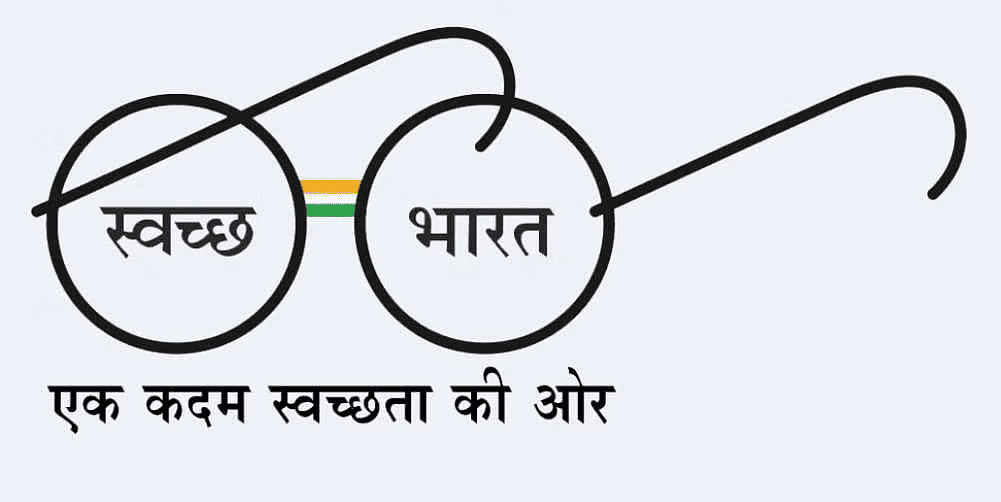
Why in news?
The Swachh Bharat Mission (SBM) has been significant in improving sanitation in India since its launch in 2014. It aims to eliminate open defecation and enhance public health through comprehensive sanitation efforts.
About the Swachh Bharat Mission (SBM)
The Swachh Bharat Mission (SBM) was initiated by the Prime Minister on October 2, 2014, aiming for universal sanitation coverage and to make India open-defecation free. The mission's key focus is to improve the health and living conditions of millions by constructing over 100 million toilets in rural areas, establishing a standard for community-driven sanitation reform.
- SBM - Gramin is funded and overseen by the Ministry of Jal Shakti.
- SBM - Urban is managed by the Ministry of Housing and Urban Affairs.
- The government provides subsidies to facilitate toilet construction.
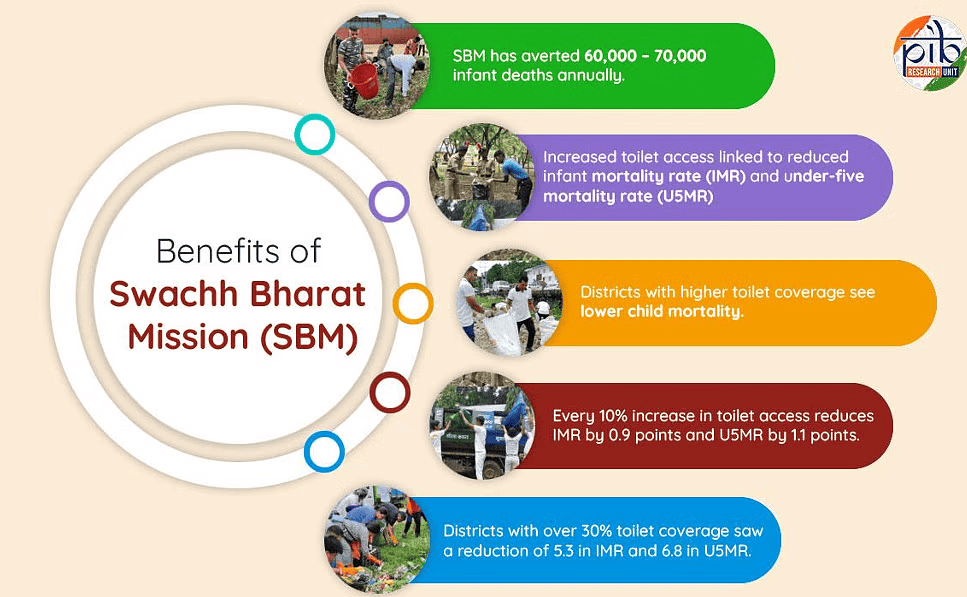
Swachh Bharat Mission – Grameen: Phase I (2014–2019)
The first phase of SBM-Grameen was a massive movement aimed at changing public behavior towards sanitation and health.
- It focused on ending open defecation through awareness campaigns, education, and infrastructure improvements.
- Community involvement significantly enhanced hygiene and health, especially in rural areas lacking sanitation facilities.
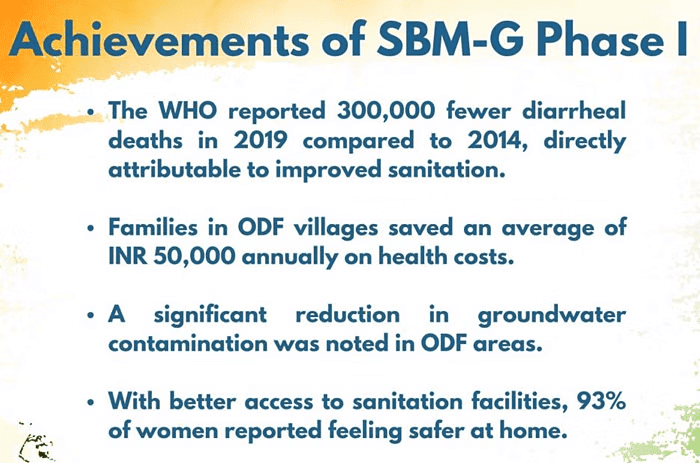
Swachh Bharat Mission – Grameen: Phase II (2019–2025)
The second phase aims to sustain open-defecation-free (ODF) status and improve waste management by 2025, promoting comprehensive cleanliness.
- The goal includes developing ODF Plus villages to elevate sanitation standards.
- With an investment of Rs. 1.40 lakh crores, this phase integrates various government schemes to enhance sanitation infrastructure.
- As of September 2024, over 5.87 lakh villages have achieved ODF Plus status.
- More than 3.92 lakh have implemented solid waste management systems.
- Over 4.95 lakh have established liquid waste management systems.
- This phase has facilitated the construction of over 11.64 crore household toilets and 2.41 lakh community sanitary complexes.
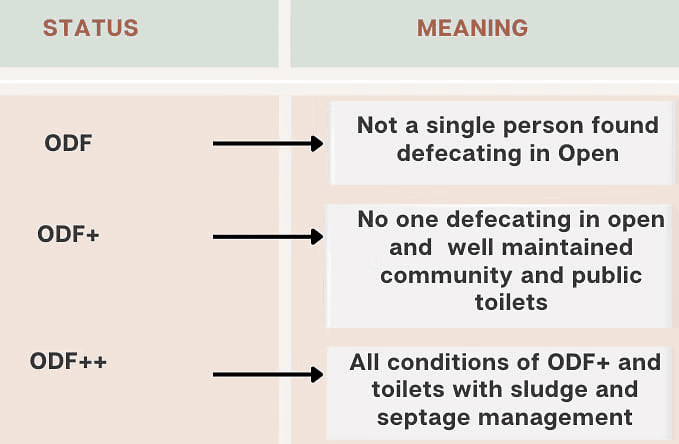
Swachh Bharat Mission – Urban
The Urban SBM aims to achieve 100% ODF status, implement scientific solid waste management, and promote behavior change through a community movement.
- As of September 2024, more than 63 lakh households and 6.3 lakh public toilets have been constructed.
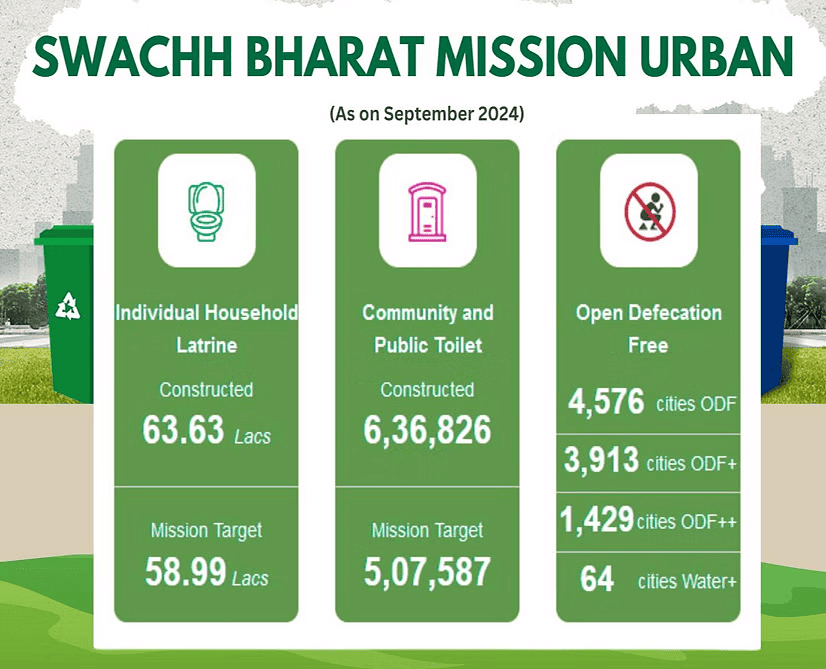
The Nature, World’s Leading Science Magazine, on The Swachh Bharat Mission (SBM)
SBM has significantly reduced infant and under-five mortality rates, saving approximately 60,000-70,000 infant lives annually.
- Increased toilet availability under SBM has improved child survival rates.
- There is a strong inverse relationship between toilet access and child mortality rates.
- A 10% rise in district-level sanitation access correlates with a reduction of 0.9 points in infant mortality and 1.1 points in under-five mortality rates.
- By combining toilet construction with information, education, and communication (IEC) initiatives, SBM has reduced exposure to diseases, resulting in lower incidences of diarrhea and malnutrition.
Significance of Swachh Bharat Mission
- More than 100 million toilets have been built, granting sanitation access to millions in rural areas.
- Achieving ODF status has led to improved hygiene and public health, especially in underserved regions.
- SBM is linked to a notable decrease in infant and under-five mortality rates due to enhanced hygiene and reduced disease exposure.
- The initiative has emphasized behavior change through IEC efforts, fostering a lasting transformation in sanitation practices across India.
- Building household toilets in rural areas has improved the dignity and safety of women, eliminating the need for unsafe outdoor defecation.
- In Phase II, the mission has expanded to include waste management strategies.
- SBM serves as a global model for community-driven sanitation reforms, demonstrating how swift improvements can result from collective action and government initiatives.
Challenges of the Swachh Bharat Mission
- While the mission focuses on achieving ODF status, maintaining this status poses challenges.
- The transition from ODF to ODF Plus is complex; many areas still lack adequate waste treatment infrastructure.
- Water scarcity in certain regions hampers the maintenance of toilets and sanitation facilities, leading to decreased toilet usage.
- Welfare of sanitation workers is a significant concern, with their working conditions often neglected.
- The urban-rural divide presents challenges, particularly in slums and informal settlements.
- Behavioral resistance exists in some communities against using toilets, especially where open defecation is traditionally practiced.
- Ensuring fair wages, proper safety measures, and improved working conditions is vital for the mission's sustainability.
Way Forward for Swachh Bharat Mission
- There is a need for developing extensive waste management infrastructure in ODF Plus villages.
- Implementing technological innovations, such as low-cost waste treatment systems, can tackle waste management challenges and ensure the continued use of sanitation facilities.
- Integrating SBM with other government initiatives, like the Jal Jeevan Mission, will improve water access for sanitation, enhancing hygiene and facility usability.
- Prioritizing the welfare of sanitation workers through better working conditions, safety gear, and dignified environments is crucial.
- Strengthening local governance and partnerships with NGOs and corporations can bolster accountability and ensure long-term success.
- Addressing urban sanitation challenges, particularly in slums, requires targeted strategies and urgent focus on slum sanitation projects.
7th Rashtriya Poshan Maah 2024
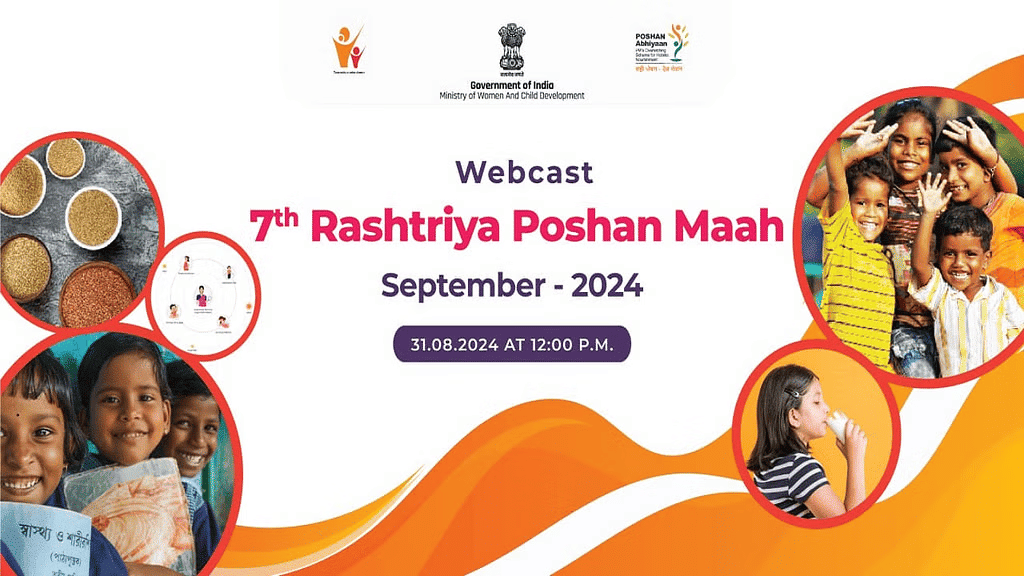
Why in news?
Recently, the Ministry of Women and Child Development inaugurated the 7th Rashtriya Poshan Maah in Dhar district, Madhya Pradesh, on September 1, 2024. The Ministry also received the National Award for e-Governance 2024 (Gold) for the Poshan Tracker initiative.
What is Rashtriya Poshan Maah?
- Rashtriya Poshan Maah is an annual campaign aimed at combating malnutrition and fostering better nutrition and health practices.
- This campaign is observed every year in September as part of the Poshan Abhiyan, which is the Prime Minister’s overarching scheme for holistic nourishment.
Key Focus Areas:
- The initiative emphasizes raising awareness about nutrition.
- It aims to improve dietary practices and tackle malnutrition, particularly among vulnerable groups such as:
- Children
- Adolescents
- Pregnant women
- Lactating mothers
- Aligned with the national vision of a ‘Suposhit Bharat’ (Well-Nourished India).
Activities:
- Various activities are organized, including:
- Plantation drives
- Distribution of nutritional supplements
- Community outreach programs
- Exhibitions and educational sessions
- For example, the campaign began with a nationwide plantation drive titled “Ek Ped Maa Ke Naam.”
Key Themes of Rashtriya Poshan Maah 2024:
- Anaemia
- Growth Monitoring
- Complementary Feeding
- Poshan Bhi Padhai Bhi
- Technology for Better Governance
What is POSHAN Abhiyaan?
- Launched in March 2018, POSHAN Abhiyaan addresses malnutrition by focusing on the nutritional needs of:
- Adolescent girls
- Pregnant women
- Lactating mothers
- Children up to 6 years old
- The initiative is implemented by the Ministry of Women and Child Development.
Objectives:
- The primary goals include:
- Reducing stunting, under-nutrition, anaemia (among children, women, and adolescent girls), and low birth weight by 2%, 2%, 3%, and 2% annually, respectively.
- Targeting children aged 0-6 years to decrease the prevalence of stunting and underweight.
- Reducing anaemia prevalence among young children (6-59 months) and women and adolescent girls aged 15-49 years.
Components of POSHAN Abhiyaan:
- Village Health Sanitation Nutrition Day (VHSND):
- This promotes coordination through target-setting, sector meetings, and decentralized planning.
- ICDS-CAS (Common Application Software):
- This employs software and growth monitoring tools to track nutritional status.
What is Poshan Tracker?
- The Poshan Tracker is a mobile app designed to track and monitor the health and nutrition of children and pregnant women in India.
- This app serves as a crucial tool for Anganwadi Workers (AWWs), reflecting the progress and impact of their interventions while enabling real-time monitoring.
- The app is interactive and measures a child's growth using World Health Organization (WHO) standards, offering suggestions for corrective actions based on inputs.
- AWWs can register six types of beneficiaries:
- Pregnant Women
- Lactating Mothers
- Children between 0-6 months
- Children between 6 months to 3 years
- Children between 3-6 years
- Adolescent Girls aged 14-18 years (specifically for Aspirational Districts)
Ovarian Cancer Awareness Month
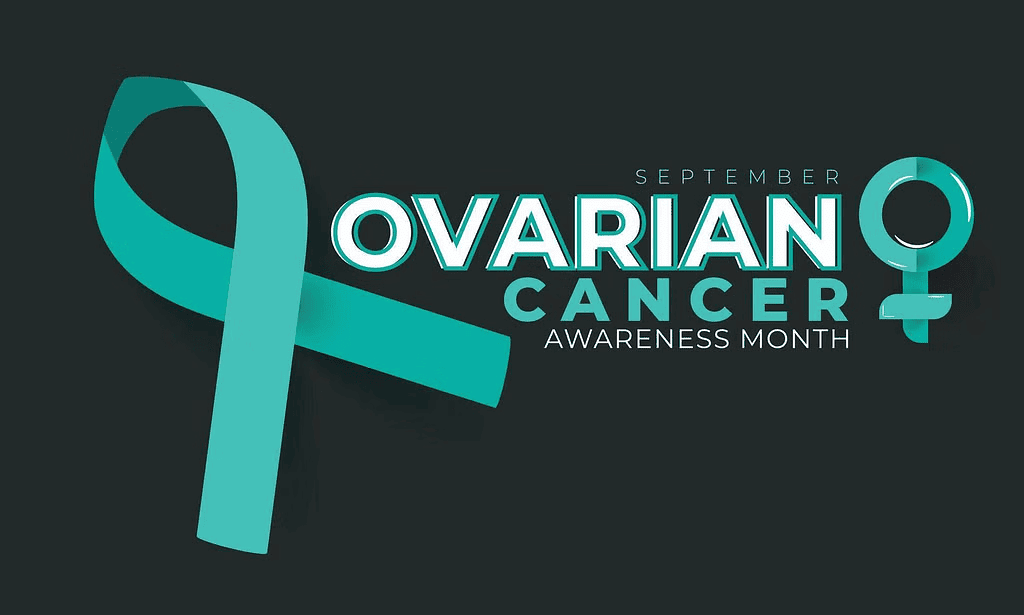
Why in news?
Ovarian Cancer Awareness Month is observed in September to enhance understanding and awareness regarding this serious disease affecting the female reproductive system.
About Ovarian Cancer

- Ovarian cancer is recognized as the most aggressive form of cancer among females, affecting individuals assigned female at birth.
- This condition arises when abnormal cells in the ovaries, peritoneum, or fallopian tubes grow uncontrollably.
The Female Reproductive System:
- The system comprises two almond-sized ovaries located on either side of the uterus.
- Ovaries are responsible for producing eggs (ova) as well as hormones such as estrogen and progesterone.
Risk Statistics:
- World: According to Globocan’s 2022 projections, the incidence of ovarian cancer is expected to rise by over 55%, reaching 503,448 diagnoses by 2050.
- Mortality: Deaths from ovarian cancer may increase to 350,956, indicating an almost 70% rise from 2022.
- India: India ranks among the top three countries for ovarian cancer, accounting for 6.6% of all female cancers. In 2022, there were 47,333 new cases and 32,978 deaths reported.
Symptoms:
- A study from 2004 indicates that women with ovarian cancer experience key symptoms 20 to 30 times each month, including:
- Persistent bloating, loss of appetite, feeling full quickly, and constipation.
- Pelvic or abdominal pain, back pain, ongoing fatigue, and weight loss.
- Urinary issues such as urgent or frequent need to urinate and postmenopausal vaginal bleeding.
Types:
- Ovarian cancer is an umbrella term encompassing more than 30 different types categorized based on the originating cell type.
- Epithelial Ovarian Cancer: This type originates in the tissue covering the ovary, within the fallopian tubes, and the lining of the abdominal wall.
- Germ Cell Ovarian Cancer: Originates from the reproductive cells in the ovaries (eggs) and is quite rare.
- Stromal Cells Ovarian Cancer: Arises from connective tissue cells within the ovary.
- Small Cell Carcinoma of the Ovary: An extremely rare form of ovarian cancer.
Cause:
- Certain lifestyle factors have been associated with a higher risk of ovarian cancer.
- Family history and inherited gene mutations are significant risk factors; approximately 65-85% of hereditary ovarian cancer cases involve mutations in the BRCA1 or BRCA2 genes.
- Use of talcum powder containing asbestos (a known carcinogen) in the genital area.
- Exposure to chemical hair products, with studies indicating a possible correlation between prolonged use of hair dyes and increased ovarian cancer risk.
- Frequent use of hair straighteners, relaxers, or products releasing formaldehyde gas.
- Hormone replacement therapy (HRT), often used for menopausal symptoms, has also been linked to a higher risk of ovarian cancer.
Detection and Diagnosis:
- Currently, there are no effective screening tests for ovarian cancer.
- The CA125 blood test can help monitor ovarian cancer after diagnosis but is less reliable for screening asymptomatic women due to potential false positives.
- Awareness of risk factors, symptoms, and family history, coupled with regular healthcare consultations, can aid in early detection.
Survival Rates:
- Five-year survival rates for ovarian cancer vary significantly by country, ranging from 36% to 46% in developed nations.
- The 10-year survival rate is estimated between 15-30%, impacted by late-stage diagnosis (70-80%).
- Generally, women diagnosed before the age of 65 tend to have better outcomes compared to older women.
Treatment:
- Surgery: This is the primary treatment for ovarian cancer, focusing on removing as much of the cancer as possible.
- Chemotherapy: Typically administered post-surgery, especially in advanced cases, often using platinum-based drugs like cisplatin or carboplatin.
- Radiation Therapy: Used after surgery to eliminate any remaining cancer cells and manage symptoms such as abdominal pain in advanced cases.
- Hormonal Treatment: Some patients may benefit from hormonal therapies using drugs like anastrozole, letrozole, or tamoxifen.
Prevention:
- The survival rate for ovarian cancer patients largely depends on the stage at which the disease is detected and the accessibility of appropriate treatments.
- Personalized Risk Management: This includes genetic testing, tailored clinical surveillance, chemoprevention, and prophylactic surgeries, which may lower the risk for high-risk women.
- Detecting Endometriosis: This condition, where tissue similar to the uterus grows outside of it, is associated with a heightened risk for certain ovarian cancer types, particularly endometrioid and clear-cell cancers.
- Genetic Counseling: This process identifies individuals at risk for hereditary cancers, providing personalized advice on preventive strategies and treatment options.
Government Initiatives Related to Cancer Care
- Ayushman Bharat Pradhan Mantri Jan Arogya Yojana (PMJAY): This scheme provides health insurance coverage up to INR 5 lakhs per family for secondary and tertiary care hospitalizations, including many cancer treatments.
- National Programme for Prevention and Control of Cancer, Diabetes, Cardiovascular Diseases & Stroke (NPCDCS): Aims to prevent and control chronic non-communicable diseases, including cancer.
- Rashtriya Arogya Nidhi (RAN): Offers financial support for patients below the poverty line suffering from life-threatening diseases like cancer at government hospitals.
- Health Minister’s Cancer Patient Fund (HMCPF): Part of RAN, it provides financial assistance for cancer treatment through the procurement of generic medications.
- First Cancer Care (FCC) initiative: Launched in 2022, it employs advanced technology to improve cancer prevention and treatment, focusing on quality, timeliness, precision, and fairness.
- State Illness Assistance Funds: Created by various state governments, these funds offer financial assistance for treatment costs of different diseases, including cancer.
- Tertiary Care Cancer Centres (TCCC): This initiative, complemented by the Pradhan Mantri Swasthya Suraksha Yojana (PMSSY), aims to establish state cancer institutes and tertiary care cancer centers nationwide.
- National Cancer Grid (NCG): A network of cancer centers, research institutes, patient groups, and charitable organizations across India, designed to standardize patient care in cancer prevention, diagnosis, and treatment.
- Awareness Campaigns: Efforts targeting tobacco control and the promotion of healthy lifestyles are essential in reducing cancer risk factors.
Lancet Study on Micronutrient Inadequacies

Why in news?
Recently, a study published in Lancet Global Health highlighted the global inadequacy of micronutrient intake, particularly for iodine, vitamin E (tocopherol), calcium, iron, riboflavin (vitamin B2), and folate (vitamin B9) across different regions and age groups. As the first global estimate based on dietary intake data, it underscores the need for nutritional interventions such as dietary modifications, biofortification, and supplementation.
What are Key Findings of the Study?
- Global Findings:
- Over 5 billion people worldwide have inadequate intakes of iodine, vitamin E, and calcium.
- More than 4 billion people are reported to have insufficient intakes of iron, riboflavin, folate, and vitamin C.
- Gender Differences:
- Women demonstrate higher inadequacies in iodine, vitamin B12, iron, selenium, calcium, riboflavin, and folate.
- Men show higher deficiencies in magnesium, vitamin B6, zinc, vitamin C, vitamin A, thiamin, and niacin.
- India-Specific Findings:
- Riboflavin, folate, vitamin B6, and vitamin B12 show significant inadequacies in India.
What are Micronutrients?
- Micronutrients are essential vitamins and minerals required by the body in very small amounts, such as iron, vitamin A, and iodine.
- They play a crucial role in producing enzymes, hormones, and other substances necessary for normal growth and development.
Impact of Micronutrient Deficiencies:
- Severe Conditions:
- Deficiencies in micronutrients can lead to serious health issues, particularly in children and pregnant women, such as anaemia.
- General Health:
- Lack of micronutrients can cause less visible but significant health problems, including reduced energy levels and mental clarity.
- Long-Term Effects:
- Deficiencies can negatively impact educational outcomes, work productivity, and increase susceptibility to other diseases.
Types of Malnutrition:
- Undernutrition:
- Wasting: Characterized by low weight-for-height, often due to inadequate food intake or infectious diseases.
- Stunting: Low height-for-age, generally resulting from insufficient calorie intake.
- Underweight: Children classified as underweight may be stunted, wasted, or both.
- Micronutrient-related Malnutrition:
- Vitamin A Deficiency: Can lead to vision impairment and weakened immunity.
- Iron Deficiency: Causes anaemia, affecting oxygen transport in the body.
- Iodine Deficiency: Results in thyroid disorders, impacting growth and cognitive development.
- Obesity:
- Caused by excessive calorie intake, often linked to sedentary lifestyles, leading to health risks such as cardiovascular diseases and diabetes.
- Defined in adults as a Body Mass Index (BMI) of 30 or more.
- Diet-related Noncommunicable Diseases (NCDs):
- Includes cardiovascular diseases, often related to high blood pressure and unhealthy diets.
What is the Status of Malnutrition in India?
- Undernourishment:
- According to the 'State of Food Security and Nutrition in the World' (SOFI) report of 2024, India has 194.6 million undernourished individuals, the highest globally.
- Child Malnutrition:
- One-third of the world's malnourished children reside in India.
- The National Family Health Survey (NFHS-5) shows approximately 36% of children under five are stunted, 19% are wasted, 32% are underweight, and 3% are overweight.
- Global Hunger Index 2023:
- India's GHI score is 28.7, categorized as serious on the GHI Severity of Hunger Scale.
- India's child wasting rate is reported at 18.7, the highest in the report.
- Regional Disparities:
- Bihar, Gujarat, Madhya Pradesh, Andhra Pradesh, and Jharkhand have notably high malnutrition rates.
- States like Mizoram, Sikkim, and Manipur show relatively better outcomes.
What are the Consequences of Malnutrition?
- Health Effects:
- Impaired Growth: Malnutrition can hinder physical and cognitive development in children.
- Compromised Immunity: Malnourished individuals often have weakened immune systems, increasing disease susceptibility.
- Nutrient Deficiencies: Insufficient intake of essential micronutrients can undermine overall health.
- Educational Impacts:
- Cognitive Delays: Poor nutrition in early childhood can lead to delays in learning and academic performance.
- Higher Dropout Rates: Malnourished children are more likely to struggle with school attendance and drop out.
- Economic Consequences:
- Reduced Productivity: Malnutrition can lead to diminished productivity, impacting national economic output.
- Rising Healthcare Expenses: High malnutrition rates increase healthcare burdens, causing greater medical costs.
- Intergenerational Effects:
- Maternal and Infant Health: Anemic mothers are more likely to have anemic babies, perpetuating poor nutrition cycles.
- Long-term Health Challenges: Malnourished children face higher risks of health problems in adulthood.
- Social Ramifications:
- Exacerbated Inequality: Malnutrition predominantly affects marginalized and economically disadvantaged populations.
- Social Stigma: Individuals with malnutrition may face discrimination, impacting their mental health.
- Impact on National Progress:
- Hindered Human Capital Development: Malnutrition limits opportunities for economic and social growth.
- Increased Strain on Healthcare: The prevalence of malnutrition diverts resources from other health initiatives.
How Can Nutrient Deficiency in India Be Addressed?
- Food Fortification: Adding essential vitamins and minerals like iron, iodine, zinc, and vitamins A & D to staple foods such as rice, wheat, oil, milk, and salt to enhance nutritional value.
- Strengthening Integrated Child Development Services (ICDS): Providing ongoing training to Anganwadi workers to improve skills in monitoring child growth and delivering nutritional education.
- Special Nutrition Programme (SNP): Ensuring that SNP delivers adequate nutritional supplements consistently across all regions, especially in tribal and slum areas.
- Creches for Working and Ailing Women: Expanding the availability of creches for children, particularly in areas with many migrant workers and low-income families.
- Wheat Based Supplementary Nutrition Programme: Implementing innovative methods to provide wheat-based products as nutritional supplements to target populations promptly.
- UNICEF Assistance: UNICEF's support encompasses a broad range of services, including health, nutrition, education, and sanitation, addressing the multifaceted nature of malnutrition.
Government Measures for LGBTQIA+ Community

Why in news?
The second meeting of the Committee, chaired by the Cabinet Secretary, convened to evaluate the actions taken by various Ministries and departments regarding issues faced by the queer community. The Committee has directed these entities to promptly issue advisories aimed at supporting this community.
Interim Actions on Ration Cards:
- The Department of Food and Public Distribution has sent a directive to all States and Union Territories (UTs) indicating that partners in a queer relationship should be recognized as part of the same household for ration card purposes.
- States and UTs are to implement necessary measures ensuring that individuals in queer relationships do not face discrimination when applying for ration cards.
Joint Bank Accounts:
- The Department of Financial Services has clarified that there are no restrictions preventing individuals from the queer community from opening joint bank accounts.
- Individuals in queer relationships can also appoint their partners as nominees to receive account balances in case of the account holder's death.
Health Care Initiatives:
- The Ministry of Health and Family Welfare has instructed States and UTs to take actions that safeguard the healthcare rights of the LGBTQI+ community.
- Key measures include raising awareness, banning conversion therapy, ensuring access to sex reassignment surgeries, and providing tele consultation services.
- The Ministry is also emphasizing the need for training healthcare staff to better understand and support the queer community.
- Guidelines are being developed for medical interventions related to intersex individuals, ensuring they live healthily and without complications.
- Additionally, the Ministry aims to facilitate the process of body claims when family members or next of kin are unavailable.
LGBTQIA+ Definition:
- The acronym LGBTQIA+ encompasses a wide range of sexual orientations and gender identities, representing diverse experiences within the community.
- Each letter signifies a group:
- L for Lesbian
- G for Gay
- B for Bisexual
- T for Transgender
- Q for Queer or Questioning
- I for Intersex
- A for Asexual
- + for other identities.
Purpose of the Acronym:
- Inclusivity: The acronym aims to include the diverse experiences and identities within the LGBTQIA+ community.
- Visibility: It promotes awareness and visibility for various identities and orientations, fostering understanding and acceptance.
- Advocacy: The acronym serves as a tool for advocating rights and equality for all individuals, irrespective of their sexual orientation or gender identity.
The Religious Composition of the World’s Migrants ReportWhy in news?
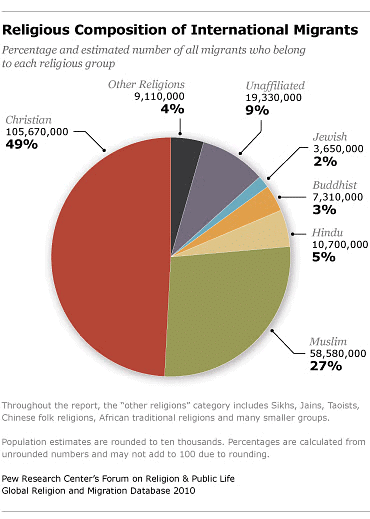
Why in news?
Recently, the Pew Research Center released a detailed report based on data collected from the United Nations and 270 censuses and surveys. The report reveals that over 280 million people, which constitutes 3.6% of the global population, were living as international migrants in 2020. Religion plays a crucial role in influencing migration trends, affecting both the decision to leave one’s homeland as well as the reception in the host country.
What are the Key Findings of the Report?
- Trend among Hindu Migrants:
- In 2020, India was identified as the leading country for both emigration and immigration.
- Approximately 7.6 million Hindus born in India were residing abroad.
- About 3 million Hindus born in other nations were living in India.
- Trend among Christians:
- Christians accounted for the largest segment of the global migrant population, making up 47%.
- Migration Trends among Religious Minorities in India:
- Religious minorities form a significant portion of Indian emigrants, representing 16% of the total, despite accounting for only 2% of the overall Indian population.
- Muslims represent 33% of all Indian-born migrants, despite being only 15% of India's population.
- India ranks as the second-largest source of Muslim migrants, with 6 million Muslims living primarily in the UAE (1.8 million), Saudi Arabia (1.3 million), and Oman (720,000).
- Trend among GCC Countries:
- The migrant population in Gulf Cooperation Council (GCC) countries has surged by 277% since 1990.
- Seventy-five percent of migrants in GCC nations are from South Asia, while Hindus and Christians represent 11% and 14%, respectively.
- As of 2020, GCC countries hosted 9.9 million Indian migrants.
- Trends in Global Migration:
- Between 1990 and 2020, the number of international migrants rose by 83%, outpacing the global population growth of 47%.
- Migrants typically travel an average distance of 2,200 miles.
- Religious Alignment and Migration Patterns:
- Migrants often choose destinations where the predominant religion aligns with their own, primarily for cultural and religious familiarity.
What is Hindu Migration Pattern and Trends?
- Global Underrepresentation:
- Hindus constitute a small fraction (5%) of global migrants, with around 13 million Hindus living outside their country of origin.
- This number is significantly lower than their global population share of 15%.
- Distance Travelled:
- Hindu migrants tend to travel longer distances, averaging 3,100 miles from their homeland, surpassing the global average of 2,200 miles.
- This represents the longest average distance among all religious groups originating from Asia.
- Regions of Destination for Hindu Migrants:
- The Asia-Pacific region hosts the largest percentage of Hindu migrants, accounting for 44%.
- The Middle East-North Africa region follows with 24%, and North America comprises 22%.
- Smaller percentages are found in Europe (8%), with very few in Latin America or sub-Saharan Africa.
- Regions of Origin for Hindu Migrants:
- The majority of Hindu migrants (95%) come from India, primarily from states that account for 57% of the world's Hindu migrants and house 94% of the global Hindu population.
- Other notable sources include Bangladesh (12% of Hindu migrants) and Nepal (11%).
- India as Destination for Hindu Migrants:
- India serves as a key destination for Hindu migrants, accommodating 22% (3 million) of the total Hindu migrant population.
- This trend is largely attributed to historical events, especially the partition of British India in 1947 and subsequent persecution in countries like Pakistan and Bangladesh.
- Notable Country Pairs for Hindu Migration:
- India to the United States: This route is the most common for Hindus, with 1.8 million migrating for opportunities in employment and education.
- Bangladesh to India: The second most frequent route sees 1.6 million Hindus migrating due to historical, social, and economic reasons.
How Diaspora Communities Boost Home-Country Growth?
- Substantial Financial Inflows:
- Communities abroad play a significant role in their native countries by sending remittances.
- In 2022, migrants from developing countries sent USD 430 billion, which is three times more than the financial aid received from other nations.
- Impact on GDP:
- In many countries, remittances form a significant part of the GDP, accounting for 37% in Tajikistan, 30% in Nepal, and around 25% in Tonga, Liberia, and Haiti.
- Diaspora Investments:
- Members of the diaspora often invest in local businesses and government bonds in their home countries, enhancing financial resources.
- Knowledge Transfer and Expertise:
- Diaspora members bring back valuable skills and knowledge acquired abroad, which can improve local productivity and capabilities.
- Bridging Knowledge Gaps:
- Individuals in the diaspora leverage their skills and global networks to assist businesses in their home countries, facilitating better market access and operational efficiency.
- For example, Indian executives in US tech firms have supported outsourcing initiatives to India.
Conclusion
- Migration and diaspora communities play a crucial role in boosting the economic growth of their home countries.
- They contribute through various means including remittances, which are money transfers sent back home.
- Additionally, they invest in their home countries, which helps create jobs and support local businesses.
- They also share valuable knowledge and skills that can benefit their communities.
- To take full advantage of these benefits, governments should focus on:
- Strengthening diaspora networks to connect people and resources.
- Lowering the barriers for investment to make it easier for expatriates to contribute.
- Reducing the costs of sending remittances so families can receive more money.
- Promoting initiatives that are led by the diaspora to encourage community-driven projects.
- These actions can lead to sustainable development and increased capital inflow into the country.
West Bengal “Aprajita” Anti-Rape Bill

Why in News?
The Aparajita Woman and Child (West Bengal Criminal Laws Amendment) Bill 2024 or ‘Aprajita’ Anti-Rape Bill has been unanimously approved by the West Bengal Legislative Assembly. This Anti-Rape Bill contains very strict provisions such that it mandates the death penalty for rape cases where the victim either dies or is left in a permanent vegetative state. The approval of this Aprajita Anti-Rape Bill follows significant public protests in West Bengal in response to the brutal rape and murder of a young doctor at R.G. Kar Medical College and Hospital in Kolkata. Though there has been legislative progress and heightened awareness in the society in India, the violence against women has remained alarmingly high. The number of incidence of crime against women like domestic violence,sexual harassment, marital rape, molestation, sexual assault, dowry-related crimes, and human trafficking is still high in India. Main causes of such incidents are the presence of a deeply ingrained patriarchal mindset, economic disparities, and orthodox cultural practices that contribute to persistent gender-based violence.
What are the Salient Features of Aprajita Anti Rape Bill?
- The Aprajita Anti Rape Bill, also known as the Aparajita Woman and Child (West Bengal Criminal Laws Amendment) Bill 2024, modifies laws related to rape in West Bengal. It updates the Bharatiya Nyaya Sanhita 2023 (BNS), the Bharatiya Nyaya Suraksha Sanhita 2023 (BNSS), and the Protection of Children Against Sexual Offences Act 2012 (POCSO).
- The new bill introduces the death penalty for certain severe cases of rape, such as when a public servant is involved. Previously, the maximum punishment was life imprisonment.
- In cases where the victim has died or is in a permanent vegetative state due to rape, the bill mandates the death penalty.
- For gang rape of women over 18 years old, the bill also stipulates the death penalty.
- For repeat offenders, the bill changes the punishment from "simple imprisonment for life" to "rigorous imprisonment for life."
- The bill increases the jail term for anyone who reveals the identity of a rape victim or publishes details about court cases related to rape.
- In cases of acid attacks, the bill eliminates lighter punishments, enforcing "rigorous imprisonment for life" as the only penalty.
- The bill amends the POCSO Act to include the death penalty for penetrative sexual assault, which previously had a maximum punishment of life imprisonment.
- The Bharatiya Nagarik Suraksha Sanhita (BNSS) has been revised to shorten the time allowed for completing investigations.
- The duration for completing trials after the chargesheet is filed has been reduced from two months to 30 days.
- The bill establishes special institutions, including Special Police Teams dedicated to investigating crimes against women, to ensure timely handling of rape cases.
- It creates a special Aparajita Task Force in each district to investigate rape cases.
- The bill also sets up Special Courts in every district to speed up inquiries and trials in rape cases, along with provisions to appoint a Special Public Prosecutor.
Present Indian Laws to Curb Sexual Violence Against Women
- Criminal Law (Amendment) Act 2013: This law was changed to allow the death penalty for cases of rape where the victim has died or is left in a persistent vegetative state. This also applies to those who commit repeat offenses.
- Criminal Laws (Amendment) Act 2018: Introduced because of strong public demand, this law enables the death penalty for rape and gang rape of girls under the age of 12.
- Bhartiya Nyaya Sanhita 2023: This law keeps the previous penalties and adds the death penalty for gang rape of women who are under 18 years old.
Similiar Anti Rape Laws to Curb Sexual Violence Against Women in Other States
- Aprajta Anti Rape Bill of West Bengal is similar to laws in other Indian states. Here are some notable anti-rape laws from various states:
- Disha Bill 2019 by Andhra Pradesh: This bill includes the death penalty for rape, especially in cases involving minors under 16 years old, gang rape, and for repeat offenders.
- Shakti Bill 2020 by Maharashtra: This law also imposes the death penalty for rape cases and sets strict timelines for finishing investigations and trials.
- In Madhya Pradesh (2017) and Arunachal Pradesh (2018), laws were created that allow for the death penalty for the rape or gang rape of girls up to 12 years old.
Issues with Introducing State Laws to Curb Sexual Violence Against Women
- The Aparajita Bill needs to get approved by the Governor of West Bengal first.
- After the Governor's approval, it must also be signed by the President of India for it to take effect.
- The approval from the President of India is essential because of a ruling by the Supreme Court in the case of Mithu vs. State of Punjab in 1983.
|
194 videos|840 docs|2241 tests
|
FAQs on Indian Society and Social Issues: September 2024 Current Affairs - General Test Preparation for CUET UG - CUET Commerce
| 1. What is the significance of the Swachh Bharat Mission (SBM) in India? |  |
| 2. What are the key objectives of the Rashtriya Poshan Maah? |  |
| 3. How does ovarian cancer awareness month contribute to public health? |  |
| 4. What were the findings of the Lancet study on micronutrient inadequacies? |  |
| 5. What measures has the government taken to support the LGBTQIA+ community? |  |
















